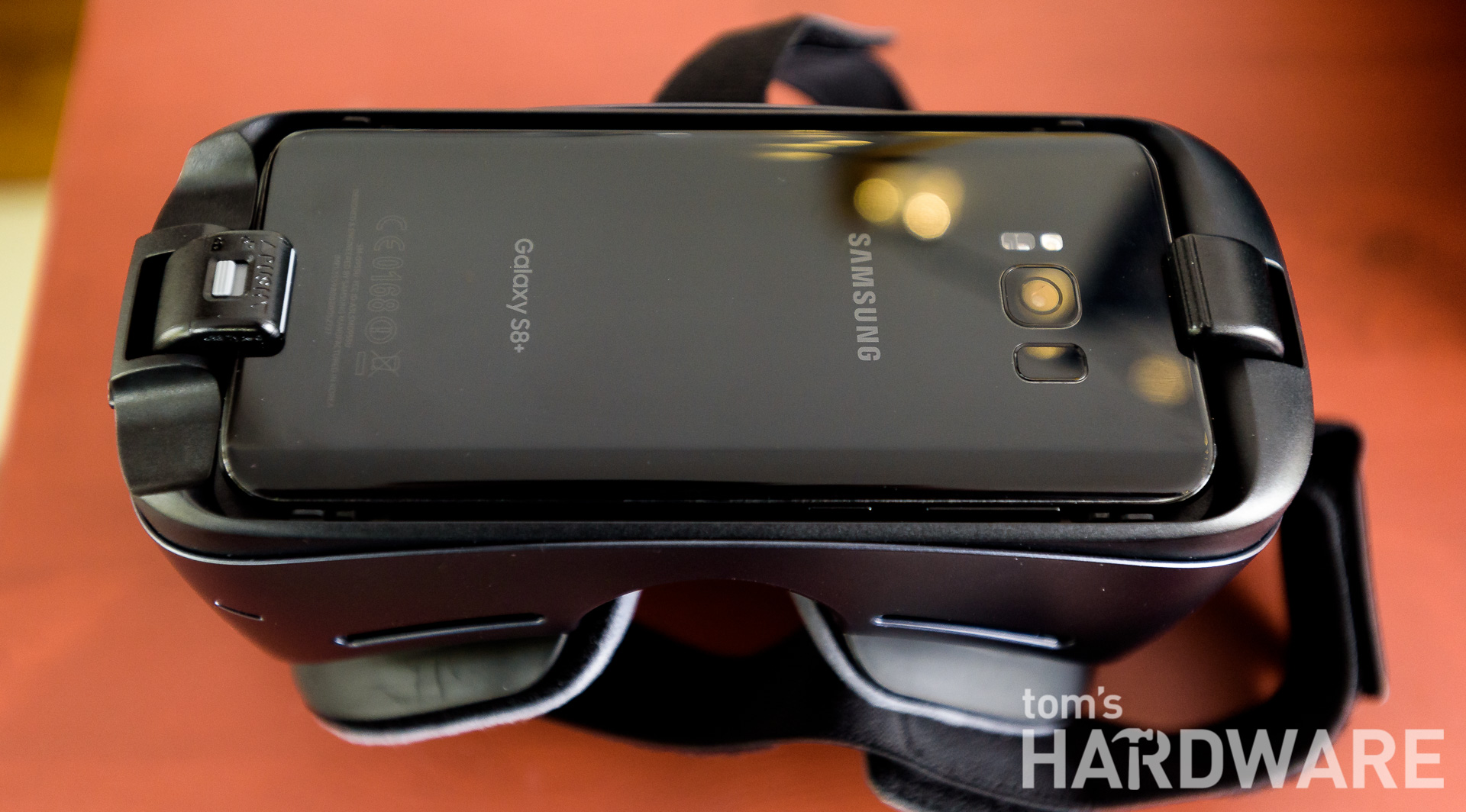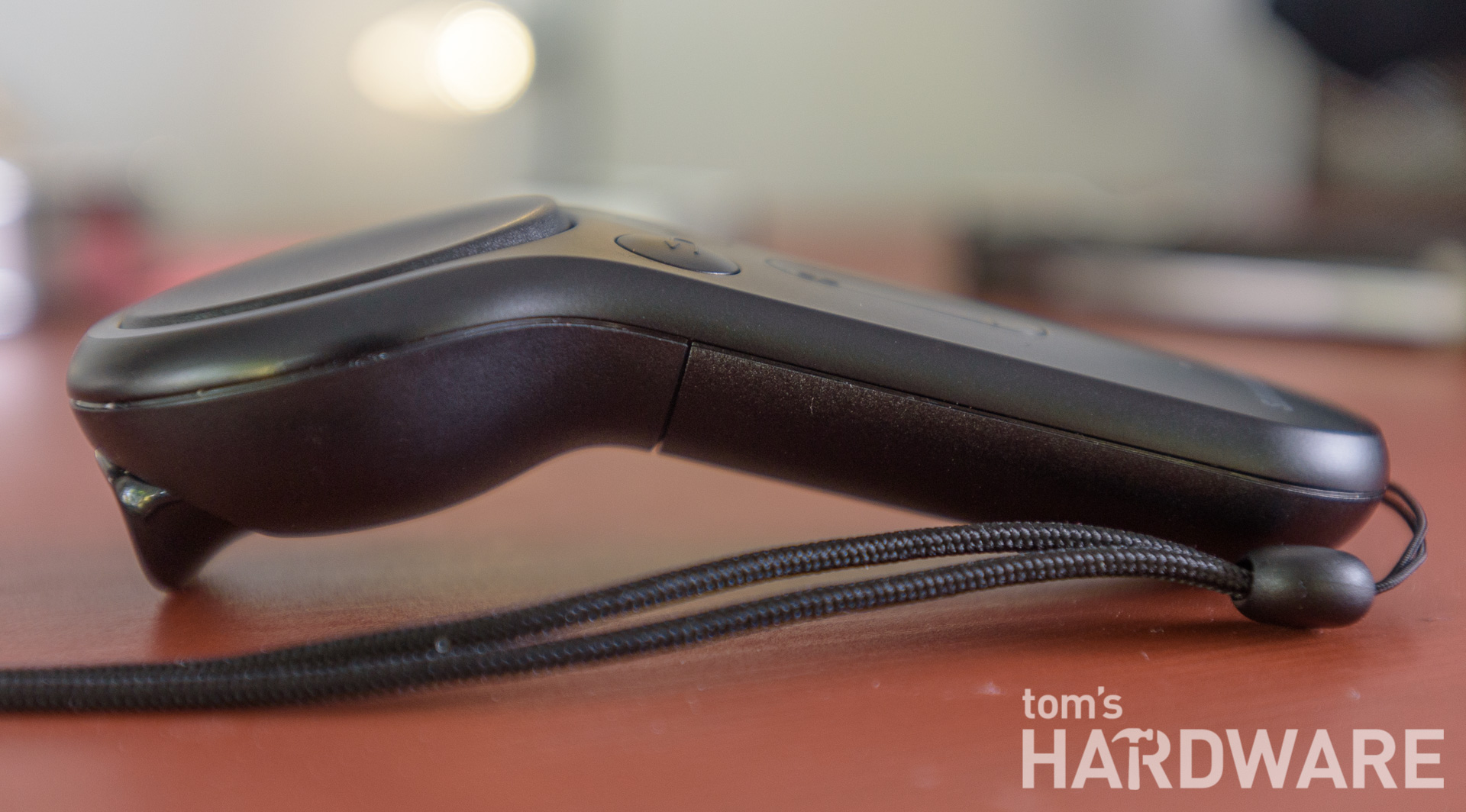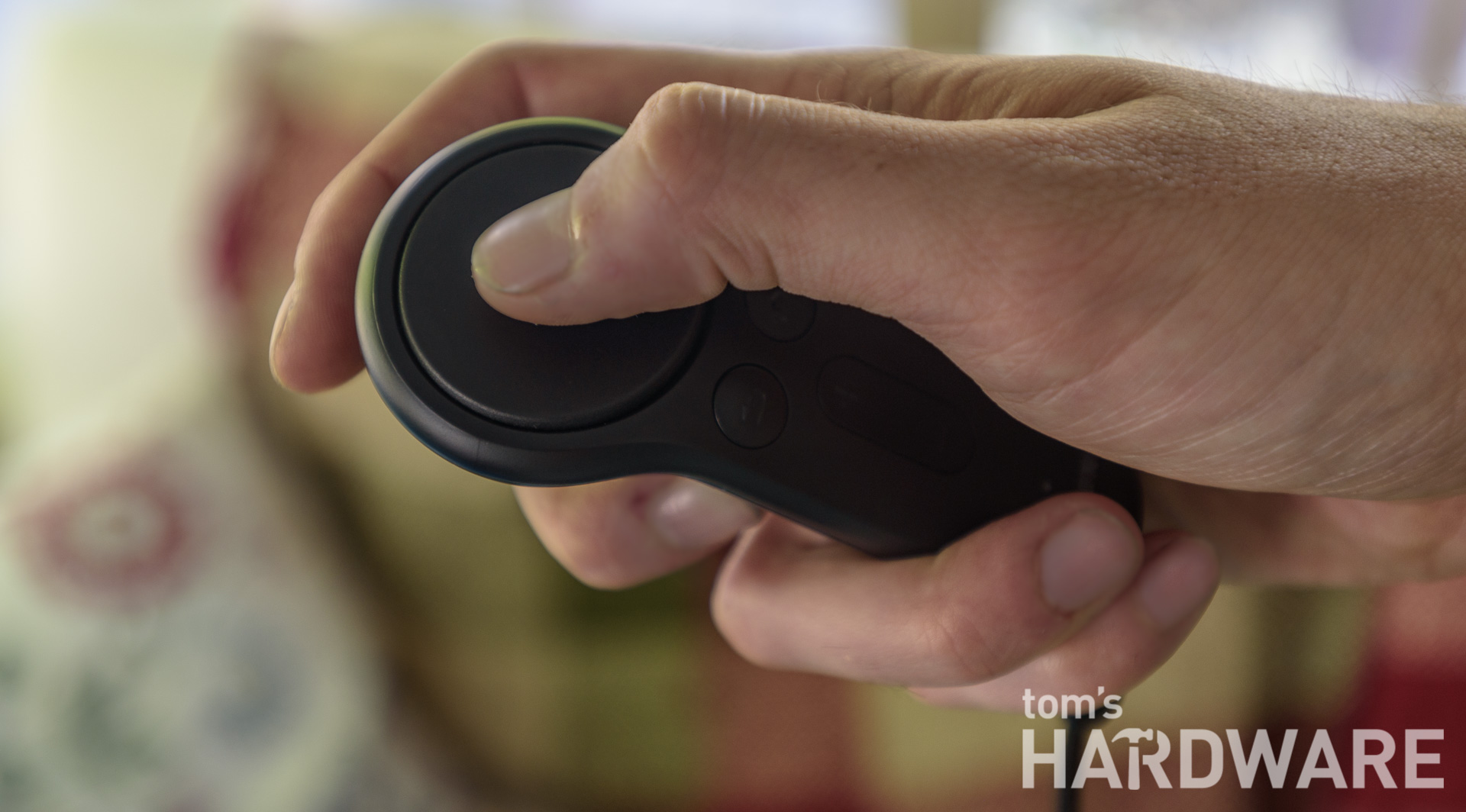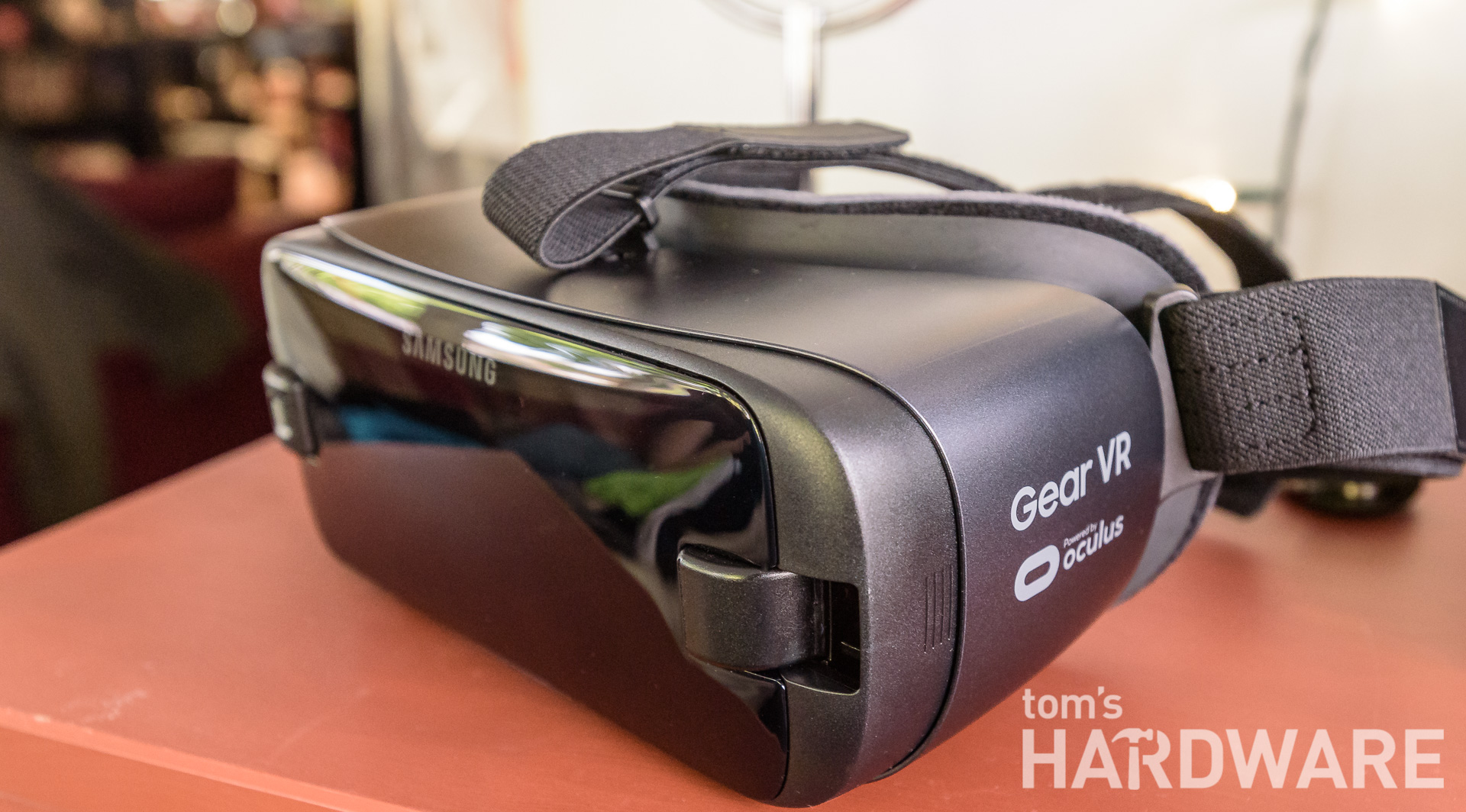Samsung Gear VR's Motion Controller, Hands On
Another year, another update to the Gear VR. Still one of the most ubiquitous mobile VR systems, the Gear VR is Samsung’s proprietary platform that turns a Galaxy (or Note) phone into a VR headset.
This is the third Gear VR (fourth, technically, as we explained in our last hands on), and it’s only a subtle change over last year’s model. The front protector is now shiny plastic, and it’s been updated to fit the Samsung S8+, but otherwise it’s the same plastic headset, the same swappable USB-C and Micro USB connectors, and the same 101-degree field of view.
It’s comfortable to wear, though a bit heavy for protracted use. My one complaint with the design of this updated model is that despite the squishy foam, I spotted some internal reflections and light leaks when I tried to use it with my back to a window. I didn’t seem to have this problem with the previous generation, but looking around the web, others did, so this may depend on your particular head shape. Reseating the foam padding can help, and either way, once I closed the blinds, the problem was solved.
Compared to the Google DayDream View, the Gear VR has always felt a bit bulkier and squishier, but at the same time that leads to a tighter fit. The Gear VR also benefits from an on-headset touchpad that allows for some intuitive, controller-less input.
Touching Encouraged
Although the on-headset input hasn’t changed, this new Gear VR is being packaged with Samsung’s new touch controller (which is literally just named “Gear VR Controller”). Taking a cue from the Daydream motion controller, this remote control-shaped device connects through Bluetooth and supports a handful of games.
The controller itself sports a clickable circular capacitive touch surface that mimics the functionality of the on-headset control surface, along with physical back and home buttons and a volume rocker. A trigger button on the back is the only real new input the controller provides, but it’s a welcome addition in many games. In most cases, the controller replaces the Gear VR’s “look at things to select it” mode of input with a cursor that you control by moving the controller.
Get Tom's Hardware's best news and in-depth reviews, straight to your inbox.
Some games and menus also assign control to swiping across the touchpad, but this generally felt imprecise and unsatisfying compared to the motion controls. For some reason, I very much wanted the touch surface to rotate, which could have provided an easier scroll function in menus.
Despite being developed with Oculus, the Gear VR controller looks oddly like a shrunken Vive controller. Its small size never bothered me, and interactions felt natural and intuitive. It does require separate batteries, but Samsung claimed that it will last around 80 hours on two AAAs. Most welcome, it connects through the phone, meaning those with older Gear VR headsets can pick up and use the new controller without replacing their headsets.
In The Palm of Your Hand
Of course, all of this matters only if the controller actually makes a difference in games. As of now (June 2017), there are around fifty games in the Oculus store that claim support for the Gear controller, and one that requires it.
With the new controller in hand, I fired up the Gear VR with the Samsung S8+ locked in. Almost immediately, I hit a snag--the controller was woefully poorly calibrated. The pointer extending from it was positioned more than 45 degrees to the right. This is no surprise--Google's Daydream controller does the same thing--but whereas Daydream reminds you ad nauseum how to (simply) recalibrate, the Gear VR was less forthcoming. One of the first messages you see should be one informing you to hold the home button to re-center the controller, but for some reason this didn’t appear the first time I entered VR, leading to 20 minutes of fruitlessly hunting through menus.
That reorient feature is key, because the controller’s cursor will drift with use. The motion control feels quick, accurate, and responsive, but after a few minutes, the in-game cursor will creep (in my case, almost always to the right). Fortunately, the re-orient command is quick enough that I found myself using it intuitively every few minutes without thinking. Still, a better method of calibration would be ideal.
Let's Play
After jumping into a series of “controller-ready” titles, I realized quickly that's a relative term. Some games don’t even use the controller’s motion tracking capabilities; it functions only as a touch input replacing the capacitive patch on the side of the headset. One title, Reflex Unit, went so far as to map aiming to your head position, movement to your finger on the touch surface, and camera rotation and special abilities to clicking different parts of the touch surface. It was one of the more awkward UI experiences I’ve ever had.
The whole experience highlighted how the Oculus store continues to be the real Achilles heel of the Gear VR. The storefront is awkward and hard to navigate, with few options for searching or sorting. Compared to the App and Play stores, the Oculus experience feels half finished and frequently frustrating. It’s a great hardware system, and mobile VR is a compelling idea, but we have yet to see the real must-have app that makes mobile VR an essential experience.
Quick Draw
Many games from the Oculus store feel half-finished, serving up the barest possible gameplay, and they last for only 20-30 minutes. But many titles command $5-10 price tags for these measly experiences. Even Dead and Buried, the only “controller-required” title in the store, proved to be nothing more than a stationary shooting gallery with such a poor interface that hitting targets was mostly a matter of luck--which is surprising given that the game is published by Oculus itself).
And then I found Drop Dead. What I expected to be yet another dull, half-formed VR shooting gallery turned out to be a remarkably fun game with great controller integration. It’s another shooter, but in the vein of the old arcade Terminator or Area 51 games, where you move through an environment, pausing periodically to blast enemies. It’s got a nonsensical time-travel plot that somehow means there are zombies, but that hardly matters when it’s also serving up dozens of levels with multiple enemy types and weapons.
Drop Dead is the first title for Gear VR that I want to go play more of. It was long enough that I didn’t finish it in one sitting, and entertaining enough that I want to go play more as soon as I’m done writing these words. It’s still by no means a perfect game, but if the Oculus store can serve up more content of this quality (and make it actually easy to find and purchase), I might make Gear VR a regular part of my gaming time. Especially if they make a VR version of Area 51.
What's Under the Hood
Mobile VR quality does depend on the device you're using, and in this case the S8 and S8+ are the ideal devices to use in the Gear VR at the moment. Both phones sport a 2960 x 1440 pixel display, with the S8 coming in at 570 ppi and the S8+ offering 529 ppi. Even so, it feels like Samsung could do better. We’ve had Samsung phones with 1440p screens around 500ppi since the Note 4. If there’s one criticism I have about almost all mobile VR systems, it’s that the pixels can still be distractingly visible once a phone is positioned an inch from your eyes. A 4k screen (or better) might be necessary for mobile VR to feel truly seamless, but mobile processors have a ways to go before they can deliver that number of pixels at the frame rates needed to avoid motion sickness.
It’s unclear what the future of VR will be, let alone mobile VR. No product has really jumped from being a novelty to a widespread hit, despite intense promotion from companies and marketers. Google and Qualcomm are looking towards standalone VR headsets as a potential solution, and if those prove successful, you can bet an all-in-one Gear VR won’t be far behind. For the time being, the Gear VR remains one of the best introductions to VR in general, and to mobile VR experiences specifically. The new controller improves on everything that was already working, but it doesn’t do much to fix the problems at the heart of the system.
-
John Wittenberg Huh. My 2016 Gear VR headset fits the S8+ just fine. Of course I had to switch out the connector with the included USB type C one, but other than that no issues.Reply -
therealduckofdeath Yeah, the 2016 model that came with the Note 7 launch is the same as the one sold now. They're selling the controller separately for anyone who wants it.Reply -
Joe Black I have one, but the batteries which were included lasted about 30s. So I have not gotten around to buying new ones yet.Reply
Mostly because I really just do not want to be tied into the Oculus ecosystem. And believe me I tried to use the Gear with SteamVR with no luck.
So yeah I really wish samsung could distance themselves from Oculus. And provide native support for streaming from a PC, with optional gear to do 6dof and better controllers. Samsung, like all the manufacturers of displays and a great tech and design company in general, is ideally positioned to really push VR gear. Yet their marriage with Oculus has held them back. -
Joe Black I should add that with the gear VR headset it should be simple for Samsung to sell a standalone screen to substitute for one of their phones for customers who want to make use of the power of their PCs.Reply
Using the Gear as a selling point for their phones might work to some extent, but I am pretty sure they'll sell many more Gear headsets and gear screens seperately.
They could have a whole range of screens. From low-end to to high-end. They'll sell hundres of thousands of those, if not millions if they went that route. -
ObamasBFF Wow, this is one of the whiniest reviewers I've ever heard. I just yesterday for the first time used the Gear VR with the S7 from one of my friends and having a full Oculus Rift setup at home and having been using VR since DK1 - I figured I'd get something, running on a phone, that wasn't very impressive and I was quite wrong. I'm an Apple guy but the VR stuff was good enough it's making me consider switching. The only real issue with the Gear VR is the low frame rate - if you're going to take VR seriously you need to have at least 90fps - and yes that's a steep hill to climb in mobile, but it really stood out. But as far as accuracy went, as far as the VR experience went, it was really impressive. This guy above is just whining about stuff - there's a difference between being critical and having unrealistic expectations. Yeah it's not on par with my $800 Oculus Rift setup on a $3000k desktop, but it's much much better than it has any right to be just putting a phone into it. With iPhones being such ridiculously powerful systems with amazing graphically performance it's a shame Apple isn't diving into a VR and it might drive me off the platform all together, the Oculus Gear VR was that good.Reply








